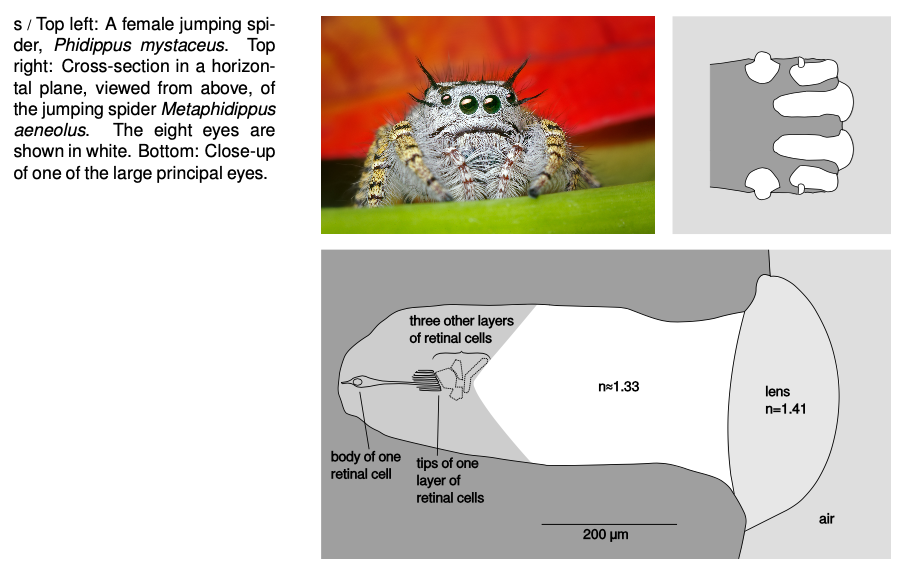LM 31.6 Case study: the eye of the jumping spider Collection
31.6 Case study: the eye of the jumping spider by Benjamin Crowell, Light and Matter licensed under the Creative Commons Attribution-ShareAlike license.
31.6 Case study: the eye of the jumping spider (optional)
Figure s shows an exceptionally cute jumping spider. The jumping spider does not build a web. It stalks its prey like a cat, so it needs excellent eyesight. In some ways, its visual system is more sophisticated and more functional than that of a human, illustrating how evolution does not progress systematically toward “higher” forms of life.

One way in which the spider outdoes us is that it has eight eyes to our two. (Each eye is simple, not compound like that of a fly.) The reason this works well has to do with the trade-off between magnification and field of view. The elongated principal eyes at the front of the head have a large value of , resulting in a large magnification . This high magnification is used for sophisticated visual tasks like distinguishing prey from a potential mate. (The pretty stripes on the legs in the photo are probably evolved to aid in making this distinction, which is a crucial one on a Saturday night.) As always with a high magnification, this results in a reduction in the field of view: making the image bigger means reducing the amount of the potential image that can actually fit on the retina. The animal has tunnel vision in these forward eyes. To allow it to glimpse prey from other angles, it has the additional eyes on the sides of its head. These are not elongated, and the smaller gives a smaller magnification but a larger field of view. When the spider sees something moving in these eyes, it turns its body so that it can take a look with the front eyes. The tiniest pair of eyes are too small to be useful. These vestigial organs, like the maladaptive human appendix, are an example of the tendency of evolution to produce unfortunate accidents due to the lack of intelligent design. The use of multiple eyes for these multiple purposes is far superior to the two-eye arrangement found in humans, octopuses, etc., especially because of its compactness. If the spider had only two spherical eyes, they would have to have the same front-to-back dimension in order to produce the same acuity, but then the eyes would take up nearly all of the front of the head.
Another beautiful feature of these eyes is that they will never need bifocals. A human eye uses muscles to adjust for seeing near and far, varying in order to achieve a fixed for differing values of . On older models of H. sap., this poorly engineered feature is usually one of the first things to break down. The spider's front eyes have muscles, like a human's, that rotate the tube, but none that vary , which is fixed. However, the retina consists of four separate layers at slightly different values of . The figure only shows the detailed cellular structure of the rearmost layer, which is the most acute. Depending on , the image may lie closest to any one of the four layers, and the spider can then use that layer to get a well-focused view. The layering is also believed to help eliminate problems caused by the variation of the index of refraction with wavelength (cf. problem 2, p. 882).
Although the spider's eye is different in many ways from a human's or an octopus's, it shares the same fundamental construction, being essentially a lens that forms a real image on a screen inside a darkened chamber. From this perspective, the main difference is simply the scale, which is miniaturized by about a factor of in the linear dimensions. How far down can this scaling go? Does an amoeba or a white blood cell lack an eye merely because it doesn't have a nervous system that could make sense of the signals? In fact there is an optical limit on the miniaturization of any eye or camera. The spider's eye is already so small that on the scale of the bottom panel in figure s, one wavelength of visible light would be easily distinguishable --- about the length of the comma in this sentence. Chapter 32 is about optical effects that occur when the wave nature of light is important, and problem 14 on p. 908 specifically addresses the effect on this spider's vision.
31.6 Case study: the eye of the jumping spider by Benjamin Crowell, Light and Matter licensed under the Creative Commons Attribution-ShareAlike license.
Calculators and Collections
Equations
- Magnification vCollections Use Equation
- Comments
- Attachments
- Stats
No comments |
